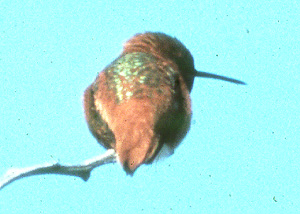
"I took a look and am certain that the Selasphorus is an adult male Rufous Hummingbird Selasphorus rufus. The central rectrix is not quite sharp enough for it to be an Allen's Hummingbird Selasphorus sasin. Rectrix #1 in S. sasin looks like it has been sharpened in a pencil sharpener....."
Notice that this identification can be made without reference to the amount or distribution of green on the back. Many Rufous Hummingbirds have green backs and are indistinguishable from Allen's Hummingbirds. Allen's is normally restricted to coastal California and is generally absent from Northern California after the end of August. Identification of either species outside their normal season or range is not advised unless the bird is in hand. The most detailed information is in "Birding" (pgs. 18-29) Vol. XXIX: No. 1, 1/97 by Heidcamp. However note there had been controversy regarding those measurements and I believe the information in "Table 2" of that article should be used with great caution.
It is often thought that males of these two hummingbirds have significantly differing display flights. However the diagrams in "The Golden Guide" make it seem easier than it really is. I recommend Mike Patterson's "Handy Hummer ID Tips" page which has a more accurate rendition of the dive displays and additional helpful information. Note that Rufous Hummingbird may include a "shuttle display" similar to Allen's as part of its dive. The whining sound made at the bottom of the long dive may differ subtly between these two.
Many additional photographs with an excellent account of separation of Rufous and Allen's Hummingbirds is at Paul Conover's outstanding Hummingbird Identification page which I highly recommend. Some pages at his site are still under construction but I think the Selasphorus accounts are superb. Great work Paul!
I agree with those who felt the nesting bird is not a Black-chinned. As the expert public commentary shows, the shapes of the inner primaries are wrong for Archilochus. Most Costa's and Anna's (Calypte sp.) in my photo collection have a longer more extensive white post-ocular stripe than the mystery bird which is one reason the bird may look a bit odd for Costa's. The nest type is also a significant generic difference, and this nest is typical Calypte. I believe the weight of the evidence favors Costa's and I have no doubt that's what it is.
The original mystery birds are below:
What do you think these birds are? Please click here to view comments or add your own. Thank you very much for contributing your thoughts.